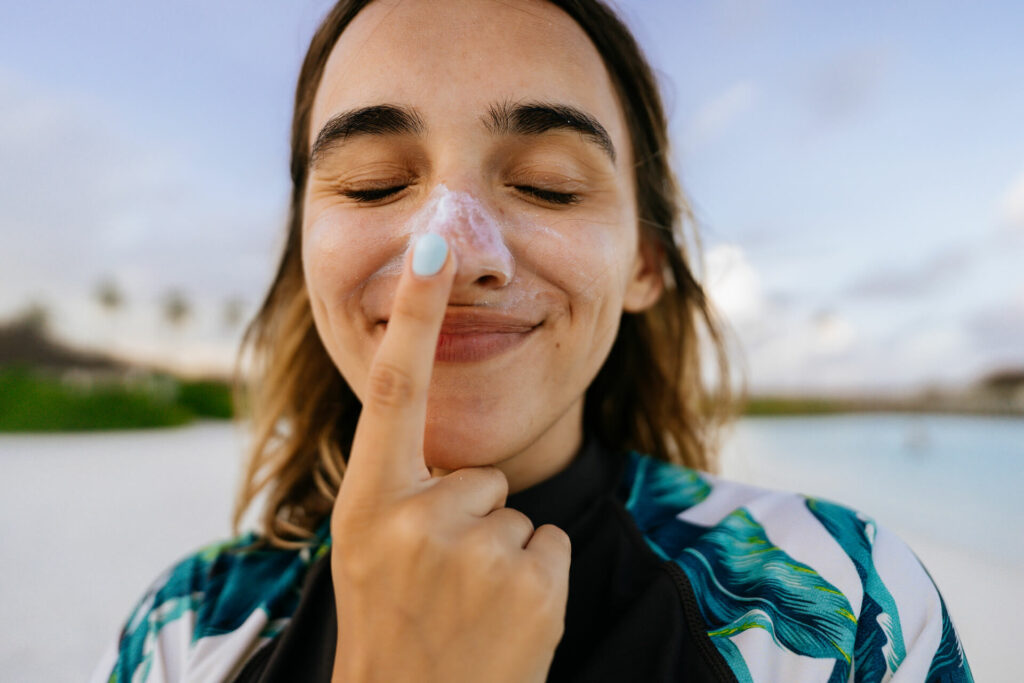
The sun can be harsh, but with our safer sunscreen guidelines, you’ll be ready to face the heat.
Whether you’re going to the beach or traveling to work, our top sun tips are:

The global sun protection market is valued at $10.9 billion, thanks to growing awareness around skin cancers and skin disorders from UV exposure.[1] Chemical and mineral sunscreens are the two most common forms of sunscreen, and both have pros and cons. Although chemical sunscreens currently dominate the market, the demand for mineral sunscreen is increasing, as it offers both UVB and UVA (two types of radiation from sunlight) protection and less harmful ingredients.
Mineral sunscreens (i.e., physical sunscreens) are safer than chemical sunscreens for your health and the planet. They contain the minerals titanium dioxide and/or zinc oxide, which physically sit on the skin’s surface (rather than penetrating the skin) and reflect or refract UV radiation from the skin.[2] Because of this, the Federal Food and Drug Administration (FDA) declared them both safe and effective in 2019.[3] Mineral sunscreens are also considered less harmful to coral reefs, which are essential to ocean health and the survival of many aquatic species.[4]
One potentially less desirable aspect of mineral sunscreens is their reputation for leaving a white cast on your skin. However, many have significantly improved in the past several years, so don’t let this deter you from trying new mineral sunscreen products.
Chemical sunscreens contain UV filters that form a thin layer on the skin, absorb UV radiation, and transform it into heat.[2] Examples of common chemical UV filters you may see on a sunscreen label include avobenzone, octinoxate, and oxybenzone (also called benzophenone-3). Many chemical sunscreens also protect people from UVA and UVB rays.
Unfortunately, the major downside of chemical sunscreens is that they contain more harmful ingredients, such as PABA, oxybenzone, and octinoxate. While chemical sunscreens may be less visible on the skin, some chemical UV filters may enter the bloodstream and are linked to health effects such as endocrine disruption and skin irritation. Additionally, they may lead to various toxicological impacts on marine life and coral reefs bleaching.[5,6,7]
Aminobenzoic acid, or PABA, was once a common UV filter. However, it has been linked to long-term health effects and is being phased out.[8] PABA and PABA derivatives used to be common in sunscreens as chemical ultraviolet B (UVB) filters. PABA may alter thyroid activity, and PABA derivatives may have additional endocrine-disrupting properties.[8] While PABA use has declined over the years, as it’s been banned and found unsafe in Canada and the European Union, the United States FDA permits PABA, regulating its use at a maximum of 15% concentration. As a result, PABA derivatives are still found in sunscreens today.
Oxybenzone has also been linked to breast cancer, Hirschsprung’s disease, and endometriosis. [6,9,10] Additionally, both oxybenzone and octinoxate are known for their harmful effects on coral reefs.
To prevent further marine harm by these toxic ingredients, Hawaii banned oxybenzone and octinoxate as of 2021.[11] Also, as of October 1, 2022, Maui banned all non-mineral sunscreens.[12] While both measures are important steps in the right direction to protect the environment, other harmful ingredients in chemical sunscreens may continue to pose a health risk. Check out the top ingredients in sunscreen to avoid below.
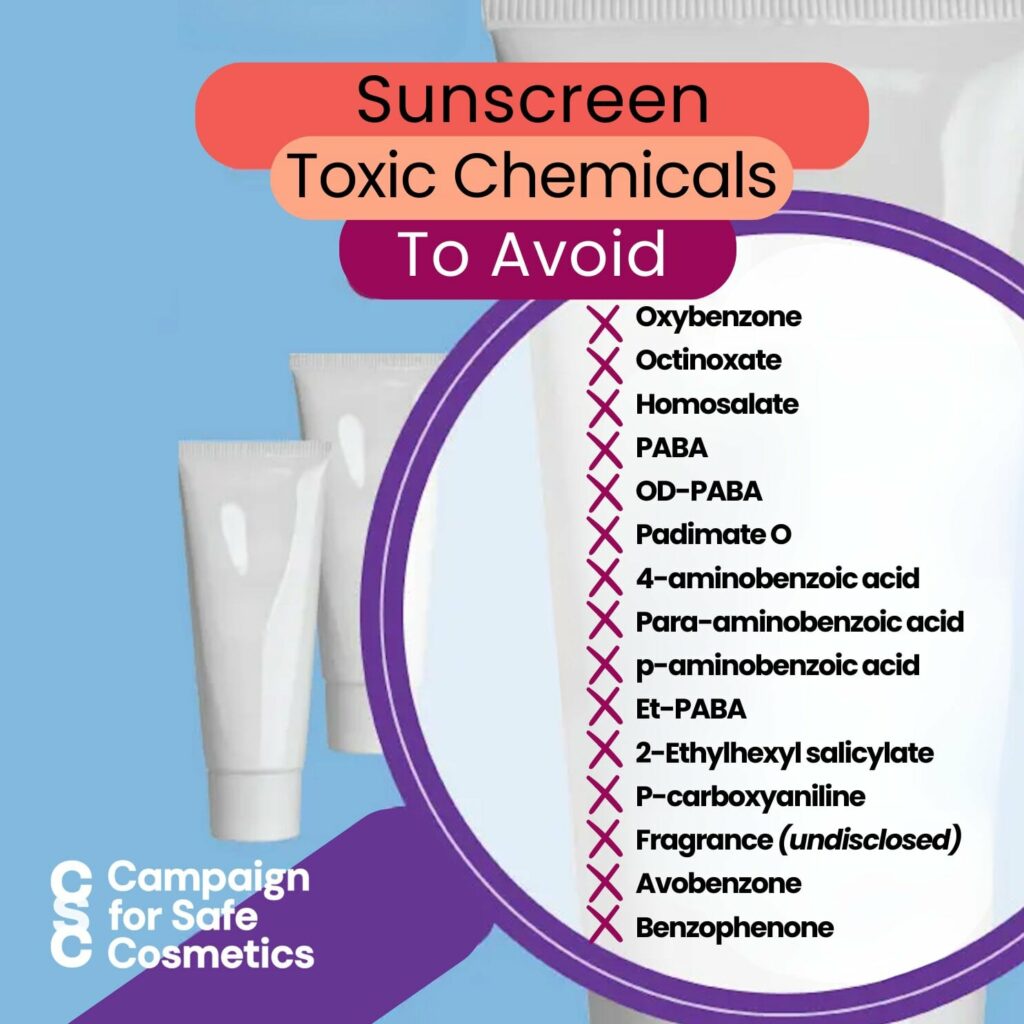
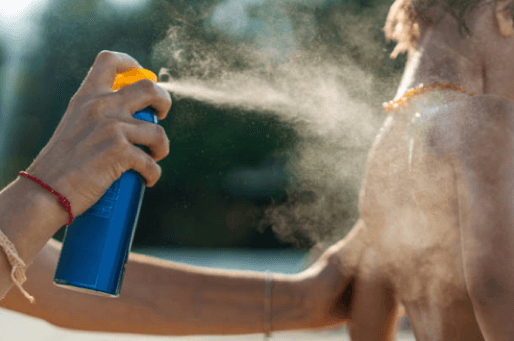

Sunscreen creams and sprays can both provide effective sun protection if applied correctly. However, some of the chemicals in sunscreen sprays can easily be inhaled, which can cause lung irritation and other health issues. Many sunscreen aerosol sprays from different brands were recalled in the last several years due to benzene contamination.[13] Benzene is a carcinogen and reproductive toxicant. Spray sunscreen can be convenient for large, hard-to-reach areas like your back. However, creams may lessen exposure to chemicals that are harmful when inhaled. This may be especially important for sensitive populations, such as young children, those with underlying respiratory conditions, or sensitive skin. We recommend using creams, if possible. That said, if a spray is all you have, it’s far better than no sunscreen at all!
The sun protection factor (SPF) value on the sunscreen indicates how much UV radiation is required to produce a sunburn on protected skin (using sunscreen) vs. unprotected skin (no sunscreen).[14] However, SPF does not measure the length of time you will be protected from UV radiation. Rather, SPF indicates the amount of UV protection the sunscreen provides. The FDA recommends choosing sunscreen with an SPF of 15 or higher, and for those with fair skin, choosing one with at least SPF 30 for UV protection.[14] Sunscreen rated above SPF 50 does not provide significantly more UV protection. In fact, products rated higher than SPF 50 may not adequately protect against UVA rays. Also, they may give a false sense of security, leading people to believe they can stay in the sun longer.[15]
The two types of UV radiation you need to protect yourself from are UVA and UVB. Broad-spectrum sunscreens protect against UV rays from both the UVA and UVB wavelengths, which is why it’s best to choose a sunscreen that falls into this category.
Nanoparticles – These are very small particles, between 1-100 nanometers (about 1/80,000 the width of a human hair).[16] Nanoparticles are used in cosmetics and sunscreens because they can improve the performance of a product. However, scientists are still trying to understand whether nanoparticles in consumer products such as sunscreen are safe. If you are concerned about nanoparticles in your products, look for words like “non-nano” on the label. We are actively continuing to investigate this research and will keep you informed of further findings.
SPF boosters – These are ingredients added to sunscreen products to increase the effectiveness of chemical UV filters. Using SPF boosters allows manufacturers to use lower amounts of chemical UV filters but enhances UV protection. This is an area of ongoing research regarding safety for human health and the environment. Keep an eye on this topic.
Fragrance – Products that contain distinct scents or smells usually have the words “fragrance” or “parfum” on the ingredient list. Fragrances are typically a combination of many different chemical ingredients. Some of these chemicals are linked to health effects such as cancer, reproductive toxicity, allergies, and sensitivities. However, because current laws don’t require disclosure, the individual ingredients in fragrances may not always be listed on the product label.[17] That’s why we recommend choosing products that label all fragrance ingredients or even avoiding products with fragrances if possible.[17]
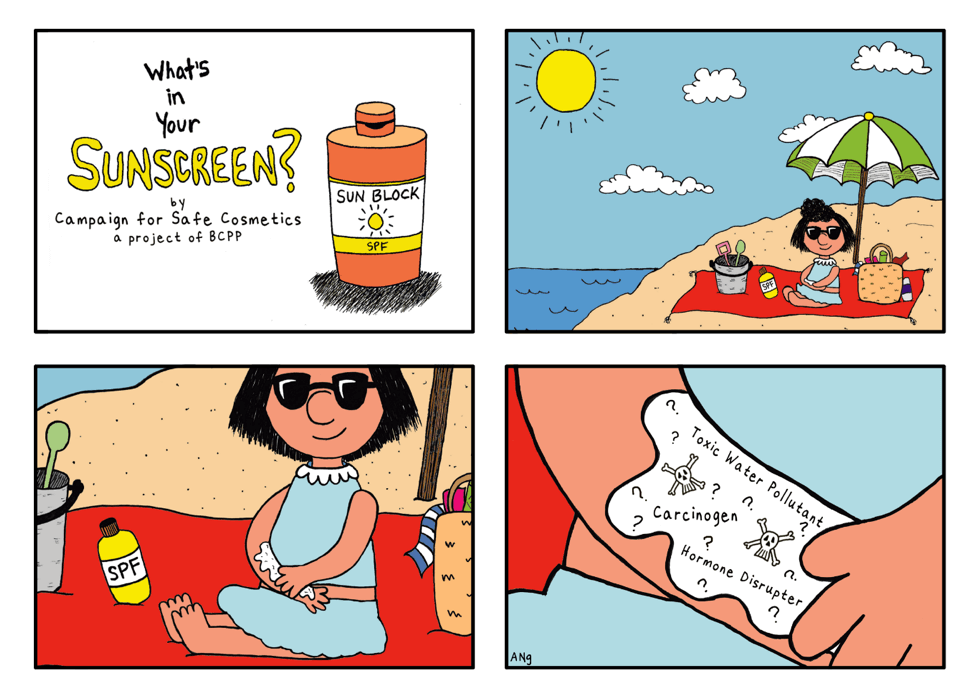
As always, the products you use and buy are a personal choice, and you know what’s best for you. Remember that the best sunscreen is the one that you will actually use. We hope that now you know the top ingredients to avoid, you are ready to choose the right sunscreen for you!
These sunscreens from our partners passed our rigorous screening standards. They are CSC-verified as free of the harmful ingredients found on our Red List of chemicals of concern in cosmetics. That’s why these are CSC’s top choices for safer sunscreens this summer and all year round.
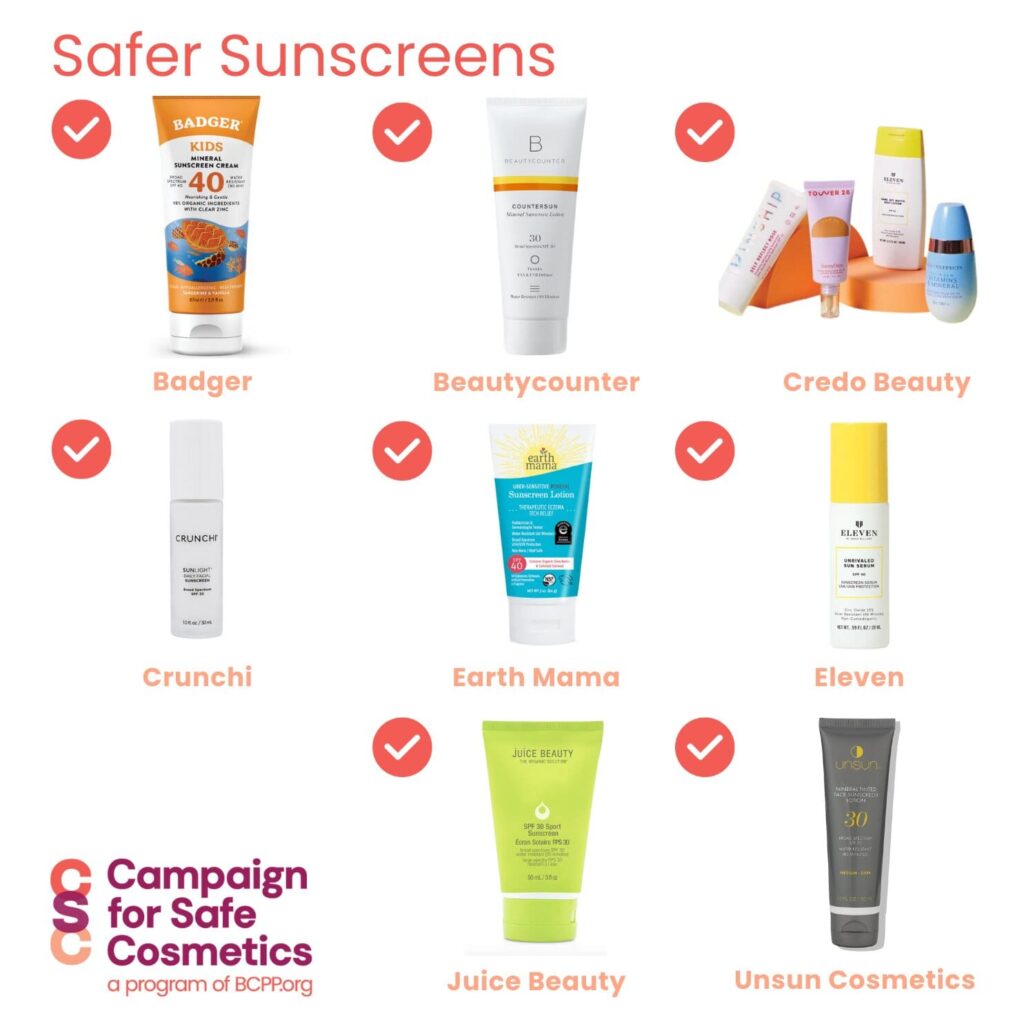
Safer sunscreens for every skin type and tone, including darker skin tones
Unsun Cosmetics: A CSC Top Black-owned Beauty Brand
Eleven: A CSC Top Black-owned Beauty Brand
Credo Beauty:
Beautycounter:
Crunchi:
Earth Mama:
Juice Beauty:
Badger:
To help make shopping for safer sunscreens a breeze, here are our top picks for finding safer, non-toxic sunscreen products:

Sunscreen is just one way to protect yourself from harmful UV rays. Wearing clothing made of tightly woven fibers in darker colors (which are more protective than lighter colors), brimmed hats, sunglasses, and staying in the shade when possible are all ways to limit UV exposure.[18] Note that labeled UPF-rated clothing is often made from polyester, which is sourced from fossil-fuel-based petrochemicals, or treated with coatings that may use toxic chemicals. The strongest UV light occurs between 10 a.m. and 4 p.m., so avoiding being in direct sunlight for long periods during these hours is also beneficial.[18] UV rays can penetrate clouds and reflect off snow, sand, and water, so make sure to wear sunglasses, keep exposed skin covered, and apply sunscreen.[18] As mentioned above, the best sunscreen is the one you actually use and works for you!
[1] Emergen Research, Sun Protection by Market Type, by Form, by Distribution Channel, and By Region Forecast to 2030. https://www.emergenresearch.com/industry-report/sun-protection-market. Accessed July 11, 2023.
[2] MD Anderson, Mineral or chemical sunscreen: Which should you choose? https://www.mdanderson.org/cancerwise/is-mineral-sunscreen-better-than-chemical-sunscreen.h00-159540534.html. Accessed July 10, 2023.
[3] U.S. FDA. An Update on Sunscreen Requirements: The deemed final order and proposed order. https://www.fda.gov/drugs/news-events-human-drugs/update-sunscreen-requirements-deemed-final-order-and-proposed-order. Accessed July 10, 2023
[4] Save the Reef, Reef Safe Sunscreen Guide. https://savethereef.org/about-reef-save-sunscreen.html. Accessed July 11, 2023.
[5] Matta MK, Florian J, Zusterzeel R, et al. Effect of Sunscreen Application on Plasma Concentration of Sunscreen Active Ingredients: A Randomized Clinical Trial. JAMA. 2020;323(3):256–267. doi:10.1001/jama.2019.20747
[6] DiNardo, JC, Downs, CA. Dermatological and environmental toxicological impact of the sunscreen ingredient oxybenzone/benzophenone-3. J Cosmet Dermatol. 2018; 17: 15– 19. https://doi.org/10.1111/jocd.12449
[7] Suh S, Pham C, Smith J, Mesinkovska NA. The banned sunscreen ingredients and their impact on human health: a systematic review. Int J Dermatol. 2020 Sep;59(9):1033-1042. doi: 10.1111/ijd.14824. Epub 2020 Feb 28. PMID: 32108942; PMCID: PMC7648445.
[8] Breast Cancer Prevention Partners, Chemicals of Concern. “PABA.” Campaign for Safe Cosmetics. Found online: https://safecosmetics.org/chemicals/paba/. Accessed July 19, 2022.
[9] Siller, Alfredo. “Update about the Effects of the Sunscreen Ingredients… Plastic and Aesthetic Nursing.” LWW. Found online: https://journals.lww.com/psnjournalonline/Abstract/2019/10000/Update_About_the_Effects_of_the_Sunscreen.11.aspx. Accessed May 27, 2022.
[10] MS, Klopcic I; Dolenc. “Endocrine Activity of AVB, 2MR, BHA, and Their Mixtures.” Toxicological sciencesSciences: an official journal of the Society of Toxicology. U.S. National Library of Medicine. Found online: https://pubmed.ncbi.nlm.nih.gov/28115641/. Accessed May 27, 2022.
[11] https://www.hawaii.com/travel-info/reef-safe-sunscreen/. Accessed 7/11/23.
[12] https://www.mauicounty.gov/2483/Mineral-Only-Sunscreen-Maui-County. Accessed July 11, 2023.
[13] U.S. FDA Recalls and Safety Alerts. https://www.fda.gov/safety/recalls-market-withdrawals-safety-alerts/coppertoner-issues-voluntary-nationwide-recall-specific-lots-pure-simple-spf-50-spray-2021-launch. Accessed July 11, 2023.
[14] U.S. FDA. How to Protect Your Skin from the Sun. https://www.fda.gov/about-fda/center-drug-evaluation-and-research-cder/sun-protection-factor-spf. Accessed July 10, 2023.
[15] Sunscreens, EWG’s Guide to. “EWG’s Guide to Safer Sunscreens.” EWG. Found online: https://www.ewg.org/sunscreen/report/whats-wrong-with-high-spf/. Accessed May 27, 2022.
[16] U.S. FDA. Cosmetics Nanotechnology. https://www.fda.gov/cosmetics/cosmetics-science-research/cosmetics-nanotechnology. Accessed July 11, 2023.
[17] Breast Cancer Prevention Partners, Chemicals of Concern. “Fragrance.” Campaign for Safe Cosmetics. Found online: https://www.safecosmetics.org/chemicals/fragrance/. Accessed July 11, 2023.
[18] American Cancer Society. How do I protect myself from Ultraviolet (UV) Rays? https://www.cancer.org/cancer/risk-prevention/sun-and-uv/uv-protection.html#:~:text=Seek%20shade,when%20UV%20light%20is%20strongest. Accessed July 11, 2023.
Looking for a Safer Alternative?
Use Clearya’s app to find non-toxic products! Clearya alerts you to toxics and helps you find safe products.
Learn more toxic chemical ingredients to avoid for your health
Get our emails to stay in the know.
This site is protected by reCAPTCHA and the Google Privacy Policy and Terms of Service apply.
get to know us
take action
BCPP is a 501(c)3 | EIN: 94-3155886 | Privacy Policy | Site Map | BCPP.org










